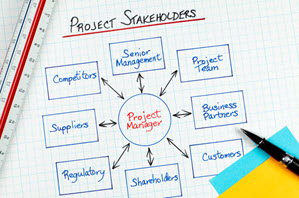 What skill must every project manager possess in order to be successful? Communication. Good, effective, efficient communication. Going into any engagement who the project manager will be communicating with is a question mark because the project itself can be more far reaching than originally imagined. And even if it isn’t much of who will actually be involved – in terms of stakeholders – will get finalized during the kickoff session (although more will usually be added along the way). At a minimum, that communication will be with the project manager’s project team, his senior management, the customer sponsor, the customer project team, possible senior leadership at the customer site, and possibly third party vendors. There even may be more stakeholders than what’s included – they do tend to get added along the way. They may even come and go throughout the project. The constant, though, is that those communication skills must be there and remain engaged throughout the project.
What skill must every project manager possess in order to be successful? Communication. Good, effective, efficient communication. Going into any engagement who the project manager will be communicating with is a question mark because the project itself can be more far reaching than originally imagined. And even if it isn’t much of who will actually be involved – in terms of stakeholders – will get finalized during the kickoff session (although more will usually be added along the way). At a minimum, that communication will be with the project manager’s project team, his senior management, the customer sponsor, the customer project team, possible senior leadership at the customer site, and possibly third party vendors. There even may be more stakeholders than what’s included – they do tend to get added along the way. They may even come and go throughout the project. The constant, though, is that those communication skills must be there and remain engaged throughout the project.
Stakeholder interfacing
The actual act of continually interfacing with the stakeholders throughout the engagement – which is a primary responsibility of the project manager – is when those communication skills…and organizational skills…will really be put to the test. In fact, that will happen very early on because in order to determine the specific goals of your project, the project manager and team will want to meet with each of the key stakeholders and document their ideas of the project goals. It’s also a good idea at this point to gain an understanding of their needs and concerns regarding the project.
Ask the stakeholders you interact with why the project is needed. Ask what business process the project will change, enhance, or replace. Perhaps the existing business processes, and the systems that support them, are so old that little documentation exists for them. Determine if there is a critical business need for this project or if it’s a “nice to have.” What will be the result of this project? Will customer service be improved, or sales increased? Find out what prevents the stakeholders today from achieving the results they hope the project will accomplish. Ask about the deliverables and how they can be verified and measured. And always ask the stakeholder how they will know that the project was completed successfully. This step is critical because when you get to the end solution, you need to know you can get the project signed off and paid for. Leaving acceptance criteria vague can result in a never-ending implementation that will blow your project budget out of the water. You must have an exit strategy in place and that needs to be built into the customer’s acceptance criteria for the project.
Identify stakeholder goals and expectations
Remember that the definition of a successful project is one that meets or exceeds stakeholders’ expectations. Understand and document those expectations and you’re off to a good start. If you feel that you don’t have a good grasp on those expectations, take additional time up front in the project to revisit this. And make sure that you include any additional required planning time in the project schedule as well.
One way to help identify project goals is to talk about what is not included in a project. For example, let’s assume the project is focused on building a new customer relationship management (CRM) system from scratch for the business. What may not be included in the project is any training that must happen or how the customer will transition from the old system to the new system. Be clear what the goals are and what is actually included in the project. By not clarifying, documenting, and managing this (which is actually part of scope management and change order management) you run the risks of going over budget and over time with extras that weren’t planned on and weren’t priced into the project.



